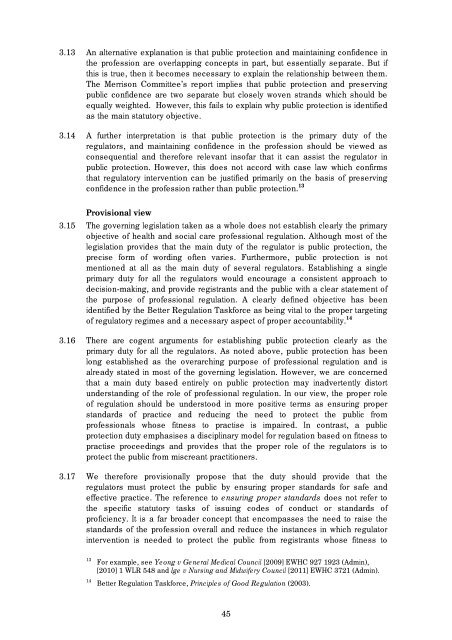Regulation of Health and Social Care Professionals Consultation
Regulation of Health and Social Care Professionals Consultation
Regulation of Health and Social Care Professionals Consultation
Create successful ePaper yourself
Turn your PDF publications into a flip-book with our unique Google optimized e-Paper software.
3.13 An alternative explanation is that public protection <strong>and</strong> maintaining confidence in<br />
the pr<strong>of</strong>ession are overlapping concepts in part, but essentially separate. But if<br />
this is true, then it becomes necessary to explain the relationship between them.<br />
The Merrison Committee’s report implies that public protection <strong>and</strong> preserving<br />
public confidence are two separate but closely woven str<strong>and</strong>s which should be<br />
equally weighted. However, this fails to explain why public protection is identified<br />
as the main statutory objective.<br />
3.14 A further interpretation is that public protection is the primary duty <strong>of</strong> the<br />
regulators, <strong>and</strong> maintaining confidence in the pr<strong>of</strong>ession should be viewed as<br />
consequential <strong>and</strong> therefore relevant ins<strong>of</strong>ar that it can assist the regulator in<br />
public protection. However, this does not accord with case law which confirms<br />
that regulatory intervention can be justified primarily on the basis <strong>of</strong> preserving<br />
confidence in the pr<strong>of</strong>ession rather than public protection. 13<br />
Provisional view<br />
3.15 The governing legislation taken as a whole does not establish clearly the primary<br />
objective <strong>of</strong> health <strong>and</strong> social care pr<strong>of</strong>essional regulation. Although most <strong>of</strong> the<br />
legislation provides that the main duty <strong>of</strong> the regulator is public protection, the<br />
precise form <strong>of</strong> wording <strong>of</strong>ten varies. Furthermore, public protection is not<br />
mentioned at all as the main duty <strong>of</strong> several regulators. Establishing a single<br />
primary duty for all the regulators would encourage a consistent approach to<br />
decision-making, <strong>and</strong> provide registrants <strong>and</strong> the public with a clear statement <strong>of</strong><br />
the purpose <strong>of</strong> pr<strong>of</strong>essional regulation. A clearly defined objective has been<br />
identified by the Better <strong>Regulation</strong> Taskforce as being vital to the proper targeting<br />
<strong>of</strong> regulatory regimes <strong>and</strong> a necessary aspect <strong>of</strong> proper accountability. 14<br />
3.16 There are cogent arguments for establishing public protection clearly as the<br />
primary duty for all the regulators. As noted above, public protection has been<br />
long established as the overarching purpose <strong>of</strong> pr<strong>of</strong>essional regulation <strong>and</strong> is<br />
already stated in most <strong>of</strong> the governing legislation. However, we are concerned<br />
that a main duty based entirely on public protection may inadvertently distort<br />
underst<strong>and</strong>ing <strong>of</strong> the role <strong>of</strong> pr<strong>of</strong>essional regulation. In our view, the proper role<br />
<strong>of</strong> regulation should be understood in more positive terms as ensuring proper<br />
st<strong>and</strong>ards <strong>of</strong> practice <strong>and</strong> reducing the need to protect the public from<br />
pr<strong>of</strong>essionals whose fitness to practise is impaired. In contrast, a public<br />
protection duty emphasises a disciplinary model for regulation based on fitness to<br />
practise proceedings <strong>and</strong> provides that the proper role <strong>of</strong> the regulators is to<br />
protect the public from miscreant practitioners.<br />
3.17 We therefore provisionally propose that the duty should provide that the<br />
regulators must protect the public by ensuring proper st<strong>and</strong>ards for safe <strong>and</strong><br />
effective practice. The reference to ensuring proper st<strong>and</strong>ards does not refer to<br />
the specific statutory tasks <strong>of</strong> issuing codes <strong>of</strong> conduct or st<strong>and</strong>ards <strong>of</strong><br />
pr<strong>of</strong>iciency. It is a far broader concept that encompasses the need to raise the<br />
st<strong>and</strong>ards <strong>of</strong> the pr<strong>of</strong>ession overall <strong>and</strong> reduce the instances in which regulator<br />
intervention is needed to protect the public from registrants whose fitness to<br />
13 For example, see Yeong v General Medical Council [2009] EWHC 927 1923 (Admin),<br />
[2010] 1 WLR 548 <strong>and</strong> Ige v Nursing <strong>and</strong> Midwifery Council [2011] EWHC 3721 (Admin).<br />
14 Better <strong>Regulation</strong> Taskforce, Principles <strong>of</strong> Good <strong>Regulation</strong> (2003).<br />
45
















